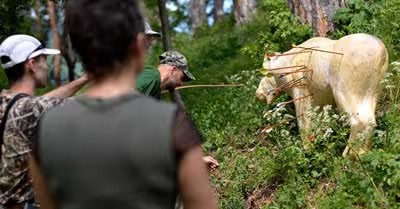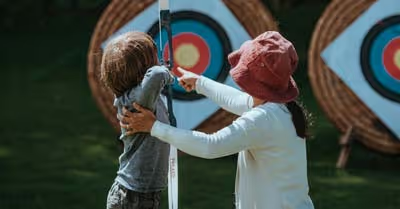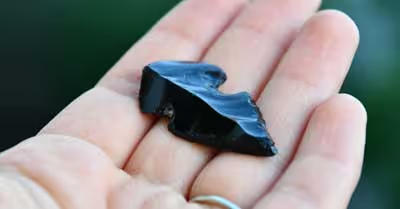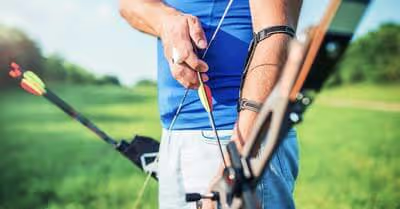Table of Contents
How common is this injury?
Archers report a very low rate of injuries. Many people might not report minor injuries, but I rarely see anyone hurt themselves practicing archery. Most archers learn to avoid string slap injuries early on.
Don't grip the bow too tightly
One common mistake new archers make is gripping the bow firmly. Gripping the bow is what instinctively feels right. However, it can make you less accurate, and it can cause the string to hit you as well.
When you grip the riser tightly, you may rotate it a little, putting your forearm in the string's path. Grip the bow by putting your thumb and index finger together. Rest the riser against the V shape between your thumb and forefinger.
Don't hold the riser too deep in your hand. Again, it should be against the fleshy pad of your thumb. If you hold it too deep in your hand, that will rotate the string towards your arm and make the string hit you.
Don't worry about a light grip ruining your accuracy. A light grip is a steady rather than shaky grip and will help you shoot better.
Many archers only hold the bow between their thumb and index finger and do not hold onto it at all. They let the bow fall after they fire, and a string prevents it from falling to the ground. Even if you hold onto the bow and do not let it drop, grip the bow lightly.
Below your thumb and below your palm, there is a fleshy part of your hand. Rest that against your bow. Hold the grip with your index finger and your thumb only. Your other fingers should be off to the side of the grip and not touching it.
Bow tuning and brace height
If you are using a traditional bow rather than a compound bow, improper bow tuning might be an issue that causes string slaps. In some but not many cases, you may need to get a new bow to solve the problem. If the brace height (the distance between the grip and the bowstring) is too short, you are more likely to get hurt.
With a recurve bow, you can increase the brace height. Detach the string and twist it enough times that the string gets shorter. This will bend the limbs of the bow back and increase the brace height.
Draw length
If you are using a bow that isn't right for you, you are more likely to get hurt. You can pull muscles if you are not comfortable with the bow you are shooting, and you can get a string slap injury as well. Most important is the draw length - how many inches you can pull the bow back, which must be proportionate to your height.
The draw length should be your height in inches divided by 2.5. If your draw length is too long, your back will be in an awkward position when you pull the bow. This awkward position will put your forearm in the string's path.
Don't rotate your elbow inward
Rotating your elbow the wrong way is one of the most common causes of string slap. Your elbow should point outward, horizontally away from you. It does not have to be perfectly horizontal, but it must point outward.
With improper form, your elbow can point inward - down and towards you. This puts your forearm in the path of the string. Pay attention to where your elbow is pointing - sometimes even experienced archers make this mistake.
Don't raise your shoulder
If you are nervous (or just concentrating), you may raise your shoulder. This can cause your elbow to turn down and inward and lead to a string slap.
Briefly think of how your arm and shoulder are positioned and correct your form if necessary before letting the string go. If your arm is tired, that can make it harder to keep your shoulder and elbow in the right position. Deliberately lower your shoulder before shooting.
Use the 2-2-3 method to achieve proper form
For experienced archers, good form comes effortlessly, even if the best archers can still make mistakes. When you aim and shoot, especially as a beginner, you need to be patient.
The 2-2-3 rule involves pausing for two or three seconds at each step so that you have time to think and avoid mistakes. While the 2-2-3 rule is the most necessary for newer archers, even Olympic archers raise, draw, and shoot the bow slowly and carefully.
First, pause for two seconds after nocking your arrow. After you put your arrow on the string, but before you raise the bow, do the pause.
Then, raise your bow and pause for two seconds again. Clear thoughts and doubts out of your mind and visualize the arrow hitting the target.
Finally, when you pull your bow back, spend three seconds aiming before you shoot. You might change the number of seconds each pause lasts if you find it works better. For example, you might pause for two seconds twice but then aim for four or five seconds.
While the 2-2-3 rule's main point is to improve your accuracy, it can also help you avoid string slap. If you pay attention when you are nocking, raising, and aiming the bow, you will have time to notice that your arm is in the wrong position.
Use a different archery stance
String slap is more common if you use a square stance, which is one of the most commonly used by beginners. With the square stance, you put your feet on either side of the shooting line, perpendicular to the target. You then turn your body to fire the arrow.
While the square stance is good for new and experienced archers in many ways - you don't have to rotate your body as much as with some other stances - it is not the best choice if you want to avoid string slap.
Switch to the open stance instead. Turn your left foot to the left, or, if you are shooting left-handed, turn your right foot to the right. With an open stance, there is no longer a straight line from your bow arm to the target, making it less likely for the string to hit your forearm.
When using the open stance, don't take it too far. If you open your stance too much, you will face the target and find it hard to maintain proper form for accurate shooting.
Avoid fatigue and don't use a powerful bow
You might shoot more than a hundred arrows when practicing, and that can tire you out, especially if you use a powerful bow. If you tire out your muscles, your form will suffer, and you are more likely to suffer a string slap. You can also pull muscles if you keep shooting after you are tired.
You don't need a bow with a powerful draw weight to shoot targets. Power matters a lot in bowhunting, but not as much in target archery. It should be easy to pull your bow back all the way.
Bend your elbow somewhat
Most archers shoot with the arm holding the grip straight. However, you may find that you can bend the elbow of the arm holding the grip and still shoot accurately. Bending your elbow can move your arm out of the path of the string.
Use an arm guard
String slap gives you a bad enough bruise that you should wear protection even if it happens to you rarely. An arm guard is not a guarantee that you won't get hurt - the string can still slap your unprotected wrist - but it can prevent a large majority of string slap injuries.
Arm guards are very cheap, so don't worry about the price. You may also buy a finger tab and a chest guard. Don't shoot a bow without proper protective equipment.
Practice makes perfect
The more practice you have shooting a bow, the easier it is to avoid injuries. Given enough time, using proper form will become instinctive, and string slaps will become unlikely.
Use proper form right from the start, as soon as you start practicing, even if it feels awkward at first. More than anything else, pay attention to whether or not your elbow is pointed in the right direction before you shoot.
Recent Articles
















